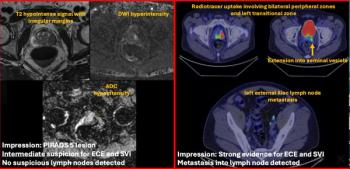
Mammography Screening with Tomosynthesis Cost-Effective
Biennial screening of women with dense breast tissue using both mammography and tomosynthesis is cost-effective.
Mammography plus tomosynthesis screening, done biennially for women aged 50 to 74 who have dense breast tissues, is cost effective compared with biennial mammography alone, according to a study published in the journal
Researchers from the University of Washington in Seattle; University of Wisconsin in Milwaukee; University of Vermont in Burlington; Dartmouth University in Dartmouth, NH; University of California-Davis, University of California-San Francisco; and Harvard Medical School Harvard Pilgrim Health Care Institute in Boston, MA, evaluated the effectiveness of the combined screening by using an established, discrete-event breast cancer simulation model.
“Screening MRI is the most sensitive breast imaging test, but is also more expensive, requires intravenous contrast injection and is currently reserved for screening women at high risk for breast cancer,” said corresponding author Christoph I. Lee, MD, assistant professor in the Departments of Radiology Health Services, University of Washington, in a release. “Digital breast tomosynthesis, in contrast to MRI, may offer operational and ease-of-use advantages since it is an integrated part of newer generation mammography units.”
The researchers used data and metrics from the National Cancer Institute’s Breast Cancer Surveillance Consortium, Medicare reimbursement rates, and medical literature. Sensitivity analyses were performed to determine the implications of varying key model parameters, including combined screening sensitivity and specificity, transient utility decrement of diagnostic work-up, and additional cost of tomosynthesis.[[{"type":"media","view_mode":"media_crop","fid":"28853","attributes":{"alt":"Christoph I. Lee, MD, corresponding author","class":"media-image media-image-right","id":"media_crop_8379951117708","media_crop_h":"0","media_crop_image_style":"-1","media_crop_instance":"2958","media_crop_rotate":"0","media_crop_scale_h":"0","media_crop_scale_w":"0","media_crop_w":"0","media_crop_x":"0","media_crop_y":"0","style":"height: 233px; width: 166px; border-width: 0px; border-style: solid; margin: 1px; float: right;","title":"Christoph I. Lee, MD, corresponding author","typeof":"foaf:Image"}}]]
The results showed that the incremental cost per quality-adjusted life year (QALY) gained by adding tomosynthesis to digital mammography screening was $53,893. An additional 0.5 deaths were averted and 405 false-positives were avoided per 1,000 women after 12 rounds of screening. Combined screening remained cost-effective (less than $100,000 per QALY gained).
The researchers concluded that if priced appropriately (up to $226 for combined examinations versus $139 for digital mammography alone), biennial combined digital mammography and tomosynthesis for women aged 50 to 74 with dense breast tissue would likely be cost-effective.
“The decrease in false-positive results after adding tomosynthesis is a major contributor to the cost-effectiveness of combined screening,” Lee explained in the release. “Our study suggests that adding tomosynthesis at the time of mammography screening has the potential to decrease the number of unnecessary diagnostic work-ups and invasive procedures that result from false-positive findings.”
Newsletter
Stay at the forefront of radiology with the Diagnostic Imaging newsletter, delivering the latest news, clinical insights, and imaging advancements for today’s radiologists.




























